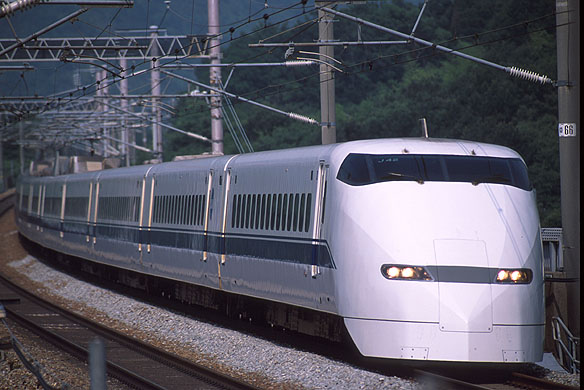300-0series
-0 subseries
-3000 subseries
Unit formation
Type index
Photos

J set with cross-arm pantographs |

J set with single-arm pantpgraphs
|
Japan National Railways (JNR) researched the faster Shinkansen train than 0 series around the middle of '80s. As the result, JNR got a conception of the new Shinkansen. That is traveling at 260-280km/h (so it can connect Tokyo and Hakata for about 5 hours), making the cross section of the body smaller, making the body weight lighter, adopting the induction motor controlled by VVVF inverter, and so on. This plan was suspended for a while because of JNR's reformation. But JR-central placed the importance on making the Shinkansen faster as the counter measure against airlines. As the result, JR-Central developed 300 series that can connect Tokyo and Shin-Osaka in 2 hours and a half. Some technological innovations were incorporated into 300 series vehicles. Aluminum body construction and bolster-less bogies give low axle weight rated at 11t/axle, which reduce destruction of track. The length and width of the body are same as 100 series, but the height of the body is 35cm lower and the cross section of the body is smaller than 100 series. Introducing the smooth surface of the body given by plug type doors lessened environmental noise. Deflectors were also fitted to reduce environmental noise.
AC induction motors (300kW) on each driven axle give a maximum service speed of 270km/h. Traction motors are controlled by the PWM inverter. 300 series adopt 3-car unit, which consists of 2 motored cars and 1 trailer car. Trailer vehicles are equipped with the main transformers that are joined to 2 main traction controllers on each motored car. Motored vehicles incorporate an AC regenerative braking system, while trailer vehicles employ eddy current braking as on the 100 series trains. The first production unit (-J29) had three cross-arm type current collectors, but this was further reduced to two on later units in order to reduce environmental noise. Current collectors were changed into single-arm type current collectors from 1999. Due to improve ride characteristics, JR Central began to give 300 series some modifications involving semi-active suspensions and non-liner air suspensions from 2004.
Passenger accommodation is in the standard layout of 2+2 seating in first class, and 2+3 in standard class. Seat pitch is same as on the 100 series vehicles with 1040mm in standard class and 1160mm in first class. Bi-level vehicles are not included. Restaurant facilities were displaced with two small refreshment counters. These counters were discontinued later.
300 series entered Nozomi services between Tokyo and Shin-Osaka from 1992. Services reached Hakata in 1993. JR Central built 61 J sets. Then JR-Central began to introduce 700 series for NOZOMI and 300 series had been withdrawn from NOZOMI service. Now 300 series are used on Hikari and Kodama services. |
|
| Technical Data |
| Items |
Data |
| Built |
1990-1998 |
| Construction |
Aluminum |
| Formation |
10M-6T |
| Supply voltage |
25,000VAC, 60Hz |
| Service speed, etc. |
Acceleration: 1.6km/h/s Service speed: 270km/h |
| Length |
26,050mm (End cars) 25,000mm (Intermediate cars) |
| Width |
3,380mm |
| Height |
3,650mm |
| Bogie |
TDT203 (motored) TTR7001 (trailer) |
| Collector |
TPS203 Cross-arm (2 per 16-car train) |
| Traction motor |
T-MT3, T-MT4, T-MT5 (300kW) |
| Gear ratio |
2.96 |
| Transformer |
TTM1 |
| Controller |
TCI1A, TCI2A (VVVF GTO invertor) |
| Air conditioner |
TAU31A1 |
| Designed by |
JR Central |
|
|



